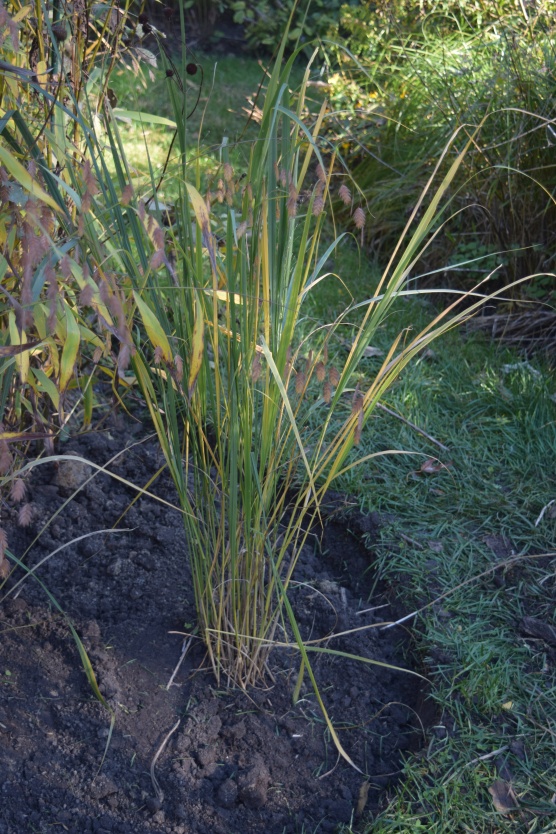Switchgrass Switching Places, Again
And now for the saga of the nomadic Switchgrass (Panicum virgatum). Today I dug out a slice of turf along a corner of the Sidewalk Border in order to create a sunny spot for said switchgrass, which had already been moved once.

Digging up grass is one of my favorite garden chores. I use an edger to cut small slices of turf, then pick up each slice and shake out the soil, throwing the grass itself onto a pile which ultimately ends up buried in the compost. This process is extremely satisfying, especially crumbling the clods of earth as they fall away from the turf roots.
Anyhow, the Switchgrass had to be moved both times because it was being shaded by neighboring perennials. This may sound unlikely given that Switchgrass grows four to six feet tall.

The problem is that Switchgrass is a warm season grass, staying dormant until around the end of May. Many other perennials have already achieved substantial height by then. The result is that in the back of even a sunny border the Switchgrass never catches up with its neighbors to get the full sun it wants. And so it goes into a slow decline.
There were no good existing spots for transplanting this substantial grass, and I hated the idea of throwing them on the compost – so expanding one of the borders seemed like the natural solution.
Like other gardening rules, the rule of thumb that tall plants go in the back of the border doesn’t always work. Tall plants that emerge late (like Switchgrass) may languish at the back of the border, depending on what’s growing around it.

I’m fairly confident that these two Switchgrass plants will like their new home. They are still at the back of a border, yes, but the back of this border faces south along a grassy path. Northern Sea Oats (Chasmanthium latifolium) and Bluestar (Amsonia tabernaemontana) grow between the new Switchgrass and the sidewalk.
My hope is that as it expands the upright Switchgrass will hold up the floppier Northern Sea Oats.
Do you always put tall plants at the back of the border?





You seem like an expert on grasses. I must admit have only recently started to appreciate them–partly because so few native grasses grow well in shade. Sounds like your plan should work well. Northern Sea Oats is one of my new favorite plants.
I am definitely no expert, I’ve just been gradually getting more absorbed into trying them out in the garden.
I do put taller plants in back but they seem to move themselves or their offspring at times to the front including some grasses.
They do have a will of their own!
Sounds a well thought through plan, although I thought that warm season grasses were supposed ideally to be moved in spring just when they come into growth. What time of year did you move it last time. I want to move some Miscanthus (also warm season) and don’t want to move it now while its looking fabulous but then spring isn’t such a good time here. Yes, I often put tall things near the front of a border to create interest.
It probably would have been better to transplant in spring. However, the clumps I transplanted were kind of hidden in the Driveway Border, now they can be seen. Also I am just a very impatient person.
I don’t have “borders” as such, but probably would plant tall things near the back. In any case it sounds like a good excuse for expanding a border. The last photo is lovely.
There’s no such thing as a bad excuse for expanding a border.
I put tall plants where I think they will look the best and that means sometimes in the back but other times in the middle of a planting.
I think that is the most sensible approach.
Panicum is so dainty that it needs to be near the front. Stipa gigantea needs to be at the front of the border too where the sun can fall on it. Another one is the tall Verbena bonariensis.
I guess there are some varieties of Panicum that are dainty but I think of it as a very substantial grass. I realize that what is front or back of the border is a matter of perspective. For my Sidewalk Border, I think of the front as along the sidewalk, facing north.
I like to mix it up. Plus, I get a rebel thrill from breaking rules. The Panicums are among my very favorite plants.
Same here, both regarding Panicums and breaking rules. Perhaps The Anarchist Gardener would be a good name for a blog.
Yes! Expanding one of the borders is always a fun thing. Your placement of this grass seems well reasoned. When I place things at the back of the border they don’t always reach the suggested height and vice versa, so you might as well play with the rules.
Exactly, as plants don’t seem to pay much attention to rules either.
Your grasses are lovely, I really do love the northern sea oats! I am constantly surprised by how high some plants grow and have giants at the front instead of the back, this year the love-in-a-mist grew to about six foot….and was in the front!xxx
Love-in-a-mist at 6′??? I thought it was supposed to grow just 1-2′!
As did I….xxx
I love the way you use grasses Jason and really would like to grow Northern Sea Oats. If its a plant you can look through I would experiment with where it was placed.
Northern Sea Oats develops into wide clumps, it’s not really a plant that makes a see through screent, like Verbena bonariensis.
Such an important piece to remember when planting! I have admired switchgrass all fall and have it down as one of my number one plants to plant next year! Oh and I hear you on the satisfaction you get when moving plants and taking cuttings and adding them to various locations in the garden….nothing better! Happy week to you Jason! Nicole
Same to you, Nicole!
That is a beautiful grass. I had read somewhere that native grasses had extensive root systems so at first I was expecting a very deep excavation project =) I usually put tall plants in the back but in one of my street front beds I put the tall plants on the street side while the shorter plants live between them and the house.
Praire grasses have amazing root systems! Take a look at this:
http://conservationresearchinstitute.org/educational-offerings.html
Oh! I have seen that chart before. Absolutely amazing!
But these were young rather underdeveloped plants. That’s why they needed a new home.
I think it depends on where the border is and how it is situated in relation to the sun. If one can be viewed from all sides sometimes you can get away with putting the taller plants in the center and work progressively shorter ones in as you move toward the edges.
Very true! Which is the front and which the back of the border is somewhat arbitrary. For this border the “front” faces the sidewalk and the “back” faces the house, but you could easily reverse these definitions.
I love switchgrass. And I love that rather than toss yours out, you made new space for it.
As to tall in back: That’s only true for me when the bed has a back. Here on the flat corner lot, most of my planting areas are viewed from every angle. So, I place accordingly.
And that is true for my beds and borders as well, but I arbitrarily assign labels to the different sides. As to tossing out the switchgrass, that just seemed like too much of a waste.
I almost stopped reading when you said digging up grass is one of your favorite things to do–wish you lived closer, Jason, and I’d trade some garden chores with you. You could dig up grass for me, and I’d plant or prune:) I lost one of my switchgrasses last year, and now I think I understand why–it was too close to some tall plants and didn’t get enough sun early in the season. I still have one grass in a pot sitting on my patio while I try to figure out where to put it–want to come down and dig up some lawn for me?:)
Hey, I can always stop by on my way back from Springfield. Do you have a hand edger?
I do not always put taller plants in the back of gardens I design. I think I like the unpredictability of mixing it up. Tall grasses on the other hand do make a nice textural backdrop for other plants, so they are often in the rear of beds. Grasses are so popular in design too!
Unpredictability is a good thing in a garden. If everything is symmetrical and orderly it can get a little boring.
That’s funny, most of my tall plants are back a ways, but the panicums are all within four feet of the border’s edge! It’s probably because they started as transplants out of a four inch pot, but maybe I was subconsciously bringing airy plants up front for design reasons 🙂
All of my brilliant design decisions are made subconsciously, or even unconsciously.
All great plants! Despite the seeding I still love Sea Oats.